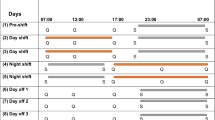Abstract
Shiftwork causes disruption in circadian and social rhythms of the shift workers. Extended hours shifts and non-rotating (permanent) shifts are increasingly being adopted in police agencies across United States. The aim of this study was to evaluate alertness, sleep, and wellness of workers in permanent shift systems in a public safety department. A self-reported questionnaire survey was administered to 39 police and security officers working in 8 and 12 h permanent shifts. When compared with the 8 h shift, 12 h shift work was associated with a significantly lower alertness level (p = 0.076), lesser sleep duration (p = 0.023), more perceived sleep insufficiency (p = 0.088), more perceived negative effect of shift type on sleep (p = 0.037), and higher frequency of back or lower back pain (p = 0.005). The results of this study are potentially useful when designing interventions to improve shift work experience.
Access this chapter
Tax calculation will be finalised at checkout
Purchases are for personal use only
Similar content being viewed by others
References
Bambra CL, Whitehead MM, Sowden AJ, Akers J, Petticrew MP (2008) Shifting schedules: the health effects of reorganizing shift work. Am J Prev Med 34(5):427–434.e30. https://doi.org/10.1016/j.amepre.2007.12.023
Åkerstedt T (2003) Shift work and disturbed sleep/wakefulness. Occup Med 53(2):89–94. https://doi.org/10.1093/occmed/kqg046
Knutsson A (2003) Health disorders of shift workers. Occup Med 53(2):103–108. https://doi.org/10.1093/occmed/kqg048
Folkard S, Tucker P (2003) Shift work, safety and productivity. Occup Med 53(2):95–101. https://doi.org/10.1093/occmed/kqg047
Smith L, Folkard S, Tucker P, Macdonald I (1998) Work shift duration: a review comparing eight hour and 12 h shift systems. Occup Environ Med 55(4):217–229. https://doi.org/10.1136/oem.55.4.217
Owen J (1985) Changing from a rotating to a permanent shift system in the Detroit police department: effects on employee attitudes and behavior. Labor Law J 36:484–489
Phillips B, Magan L, Gerhardstein C, Cecil B (1991) Shift work, sleep quality, and worker health: a study of police officers. South Med J 84(10):1176–1184
Amendola K, Wyckoff L, Hamilton E, Jones G, Slipka M (2011) The impact of shift length in policing on performance, health, quality of life, sleep, fatigue, and extra-duty employment. Police foundation report. https://www.policefoundation.org/publication
Amendola K, Hamilton E, Wyckoff L (2011) Trends in shift length: results of a random national survey of police agencies. Police foundation report. https://www.policefoundation.org/publication
Barton J, Spelten E, Totterdell P, Smith L, Folkard S, Costa G (1995) The standard shiftwork index: a battery of questionnaires for assessing shiftwork-related problems. Work Stress 9(1):4–30. https://doi.org/10.1080/02678379508251582
Di Milia L (1998) A longitudinal study of the compressed workweek: Comparing sleep on a weekly rotating 8 h system to a faster rotating 12 h system. Int J Ind Ergon 21(3–4):199–207. https://doi.org/10.1016/S0169-8141(97)00039-5
Kecklund G, Eriksen CA, Åkerstedt T (2008) Police officers attitude to different shift systems: association with age, present shift schedule, health and sleep/wake complaints. Appl Ergon 39(5):565–571. https://doi.org/10.1016/j.apergo.2008.01.002
Ong CN, Kogi K (1990) Shiftwork in developing countries: current issues and trends. Occup Med (Philadelphia, Pa.) 5(2):417–428
Paley MJ, Price JM, Tepas DI (1998) The impact of a change in rotating shift schedules: a comparison of the effects of 8, 10 and 14 h work shifts. Int J Ind Ergon 21(3–4):293–305. https://doi.org/10.1016/S0169-8141(97)00048-6
Schroeder DJ, Rosa RR, Witt LA (1998) Some effects of 8- vs. 10-h work schedules on the test performance/alertness of air traffic control specialists. Int J Ind Ergon 21(3–4):307–321. https://doi.org/10.1016/S0169-8141(97)00044-9
Author information
Authors and Affiliations
Corresponding author
Editor information
Editors and Affiliations
Rights and permissions
Copyright information
© 2019 Springer Nature Switzerland AG
About this paper
Cite this paper
Sengupta, A., Aydin, Z., Lieber, S. (2019). Differential Effects of 8 and 12 Hour Non-rotating Shifts on Alertness, Sleep and Health of Public Safety Workers. In: Bagnara, S., Tartaglia, R., Albolino, S., Alexander, T., Fujita, Y. (eds) Proceedings of the 20th Congress of the International Ergonomics Association (IEA 2018). IEA 2018. Advances in Intelligent Systems and Computing, vol 819. Springer, Cham. https://doi.org/10.1007/978-3-319-96089-0_56
Download citation
DOI: https://doi.org/10.1007/978-3-319-96089-0_56
Published:
Publisher Name: Springer, Cham
Print ISBN: 978-3-319-96088-3
Online ISBN: 978-3-319-96089-0
eBook Packages: Intelligent Technologies and RoboticsIntelligent Technologies and Robotics (R0)




